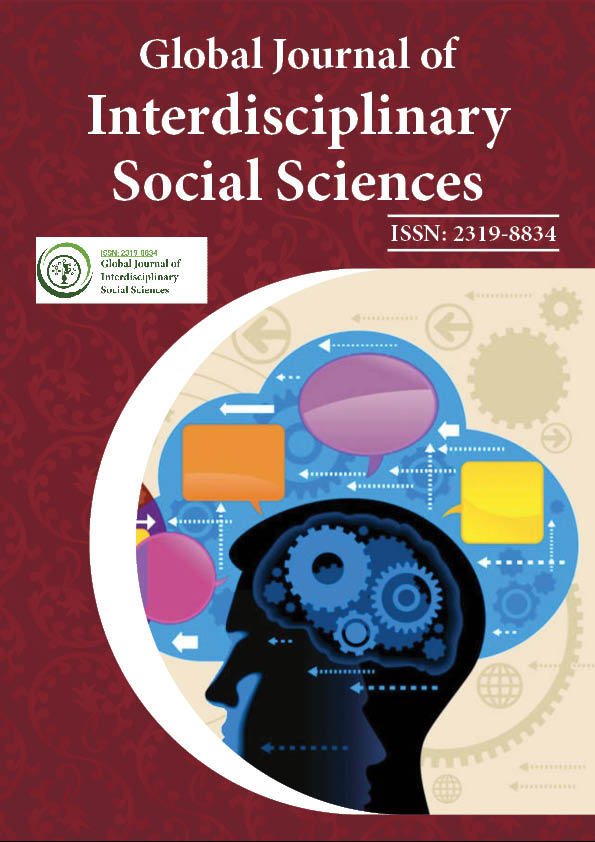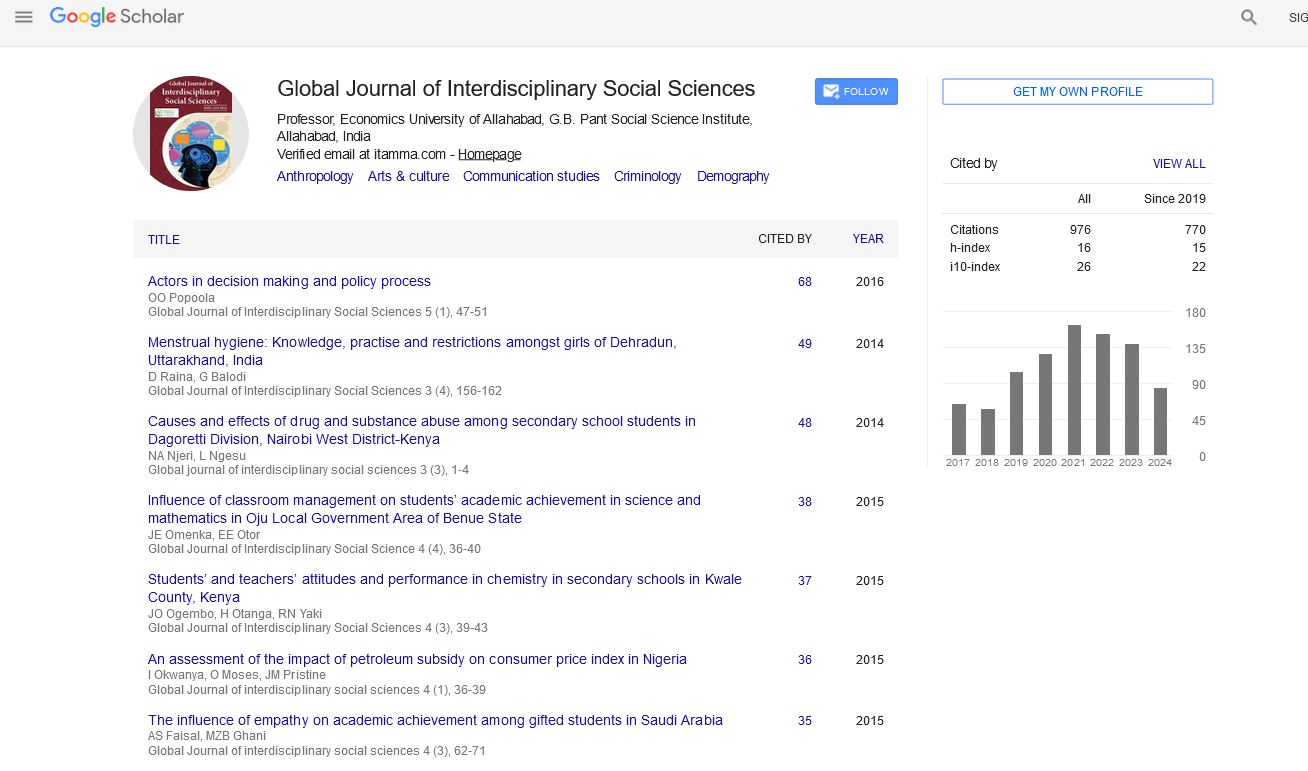Indexed In
- JournalTOCs
- Google Scholar
Useful Links
Share This Page
Journal Flyer

Open Access Journals
- Agri and Aquaculture
- Biochemistry
- Bioinformatics & Systems Biology
- Business & Management
- Chemistry
- Clinical Sciences
- Engineering
- Food & Nutrition
- General Science
- Genetics & Molecular Biology
- Immunology & Microbiology
- Medical Sciences
- Neuroscience & Psychology
- Nursing & Health Care
- Pharmaceutical Sciences
Opinion Article - (2023) Volume 12, Issue 3
The Impact of Living Arrangements on Student Well-Being: On-Campus vs. Off-Campus
Maria Isabella*Received: 28-Aug-2023, Manuscript No. GJISS-23-23632 ; Editor assigned: 30-Aug-2023, Pre QC No. GJISS-23-23632 (PQ); Reviewed: 13-Sep-2023, QC No. GJISS-23-23632 ; Revised: 20-Sep-2023, Manuscript No. GJISS-23-23632 (R); Published: 27-Sep-2023, DOI: 10.35248/2319-8834.23.12.066
Description
The experience of studying abroad is a transformative one, offering students the opportunity to extend their horizons and gain a deeper understanding of the world. The choice of living arrangements, whether on-campus or off-campus, can significantly impact the well-being, perceived conflict, and intergroup attitudes of local and international students. This article explores the effects of living arrangements on these aspects and compares the experiences of local and international students analyze on the unique challenges and benefits each group encounters.
Well-being is a multifaceted concept, including physical, emotional, and social dimensions. For both local and international students, on-campus living offers certain advantages. The convenience of proximity to classes, academic resources, and a built-in support system can positively impact well-being. Students residing on campus often report feeling more connected to their educational institutions and fellow students, which can reduce feelings of isolation and stress.
However, the benefits of on-campus living are not without drawbacks. Limited personal space and the constraints of dormitory life can lead to feelings of claustrophobia, and conflicts with roommates are common. International students, in particular, may experience culture shock, homesickness, and a sense of isolation due to the unfamiliarity of their surroundings.
In contrast, off-campus living offers more autonomy and personal space, which can be advantageous for some students, especially local students who are familiar with the area. These students may enjoy the opportunity to live independently, away from the constraints and rules of on-campus housing. In many cases, they have a support system in the form of family or friends nearby.
However, off-campus living is not without its challenges. Commuting can be time-consuming and tiring, potentially affecting student’s well-being. For international students, securing off-campus housing can be a complicated and stressful process, which may involve navigating language barriers and unknown rental markets.
Understanding conflict is a critical aspect of students’ experiences, and living arrangements can significantly impact it. On-campus living often exposes students to a more diverse group of peers, fostering interactions with individuals from various backgrounds and cultures. This diversity can contribute to the development of open-mindedness, empathy, and an appreciation of different opinions. Nevertheless, it can also lead to conflicts, particularly when differences in cultural norms and communication styles clash.
International students, in particular, may find themselves navigating unfamiliar social norms and etiquette. This can lead to perceived conflict with local students who may not understand the challenges faced by their international students. Communication breakdowns, misunderstandings, and occasional stereotyping can emerge as barriers to balanced relationships.
On the other hand, off-campus living may expose students to a more homogenous group, reducing the potential for intercultural conflict. Local students, in particular, may maintain their existing social networks, leading to limited exposure to diversity. However, this lack of diversity can also hinder personal growth and intercultural understanding, limiting the opportunities for personal development and global perspective.
The impact of living arrangements on intergroup attitudes is an essential aspect of the student experience. On-campus living often facilitates the formation of united communities where students from various backgrounds interact regularly. Such interactions can lead to the development of more positive intergroup perspective, as students are exposed to diverse opinions and cultural exchanges.
In contrast, off-campus living may limit students' exposure to individuals from different backgrounds. Local students, in particular, may have fewer opportunities to engage with international students. This reduced interaction can hinder the development of positive intergroup opinions, potentially leading to limited thinking and ethnocentrism.
While both local and international students experience the impact of living arrangements, their experiences differ in significant ways. International students, in particular, face unique challenges related to cultural adaptation, language barriers, and social integration. The choice of living arrangements can be complicate or reduce these challenges.
International students often benefit from on-campus living due to the immediate access to a supportive community of fellows. They have the chance to interact with local students and engage in cultural exchange, enhancing their understanding of the host country. However, they may also face conflicts due to differences in communication styles and social norms, leading to heightened stress and feelings of isolation.
In conclusion, the choice of living arrangements significantly influences the well-being, perceived conflict, and intergroup opinions of both local and international students. On-campus living can promote diversity, intercultural understanding, and a sense of belonging, but may also lead to conflicts and stress. Offcampus living offers more autonomy and personal space but can resist intercultural interactions and personal growth. Understanding these dynamics is essential for educational institutions and local communities as they seek to create a supportive and inclusive environment for all students, regardless of their background.
Citation: Isabella M (2023) The Impact of Living Arrangements on Student Well-Being: On-Campus vs. Off-Campus. Global J Interdiscipl Soc Sci. 12:066.
Copyright: © 2023 Isabella M. This is an open-access article distributed under the terms of the Creative Commons Attribution License, which permits unrestricted use, distribution, and reproduction in any medium, provided the original author and source are credited.

